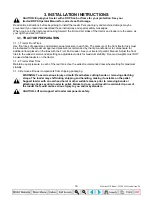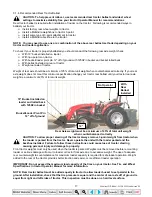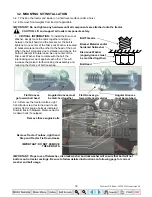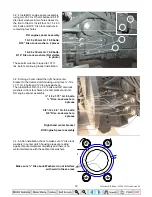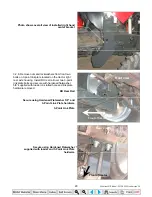
5
SAFETY PRECAUTIONS
BEFORE OPERATION
26. Before starting the engine of your tractor, make sure all operating controls are in park lock or neutral
position.
27. Be certain lights and safety markings, as provided by the tractor manufacturer, are clean and operating
when transporting the tractor/loader on public roads. Be certain that the Slow Moving Vehicle (SMV)
emblem is visible. Check with local law enforcement for specific requirements.
28. Rear tractor ballast is required after installation of loader on the tractor. To allow for proper steering of the
tractor always remove 3-point weight when the loader is parked from the tractor. Never operate the unit
with the loader parked. Failure to follow these instructions could cause loss of steering causing personal
injury and damage to property.
OPERATION
29. Add wheel ballast and/or rear weight to counterbalance tractor/loader for stability at maximum loader
capacity.
30. Additional counterweight requirements will vary with loader attachments and equipment application.
31. Move and turn the tractor at low speeds.
32. Carry loader boom at a low position during normal operation.
33. Never travel at high speeds with bucket loaded.
34. Use caution when operating the loader with a raised bucket or attachment.
35. Avoid driving over loose fill, rocks, holes, or anything that may be dangerous for loader operation or
movement.
36. Allow for the loader length when making turns.
37. Use caution when handling loose or unstable loads.
38. Gradually stop the loader boom when lowering or lifting loads.
39. When using remote hydraulic tractor valves on some tractors, the loader lift and dump cylinders will
continue moving unless the valve handle/handles are manually returned to neutral, or until relief pressure
is reached at the ends of piston strokes. Observe the bucket movement and maintain control with valve
handle/handles.
40. Travel speed should be such that complete control and machine stability is maintained at all times. Where
possible, avoid operating near ditches, embankments, and holes. Reduce speed when turning, crossing
slopes, and on rough, slick or muddy surfaces.
41. A loader attachment should be transported in a low position at slow ground speeds. Make turns slowly
and use the tractor brakes cautiously. A loaded attachment in the raised position alters the center of
gravity location of the machine and increases the possibility of mishaps.
42. Be careful during loading, transporting, and stacking to minimize rolling bales and tractor tip over.
43. Do not use buckets, forks, or other attachments without bale retaining devices.
44. Operate the tractor and loader such that complete control and machine stability is maintained at all times.
45. When using a loader, be alert of bucket or attachment position at all times. Loader in raised position with
bucket or attachment rolled back can dump material onto tractor causing damage or injury to tractor
and/or operator.
LARGE HEAVY OBJECTS
46. Never use loader for handling large heavy objects, such as large round or rectangular bales, logs, and oil
drums unless loader is equipped with attachment that is designed to handle such objects.
47. Handling large heavy objects can be extremely dangerous due to danger of rolling the tractor over.
48. Handling large heavy objects can be extremely dangerous due to danger of upending the tractor.
49. Handling large heavy objects can be extremely dangerous due to danger of the object rolling or sliding
down the loader boom onto the operator.
35 Series 4WD, Model - 3535 & 4035 Loader June’08

















